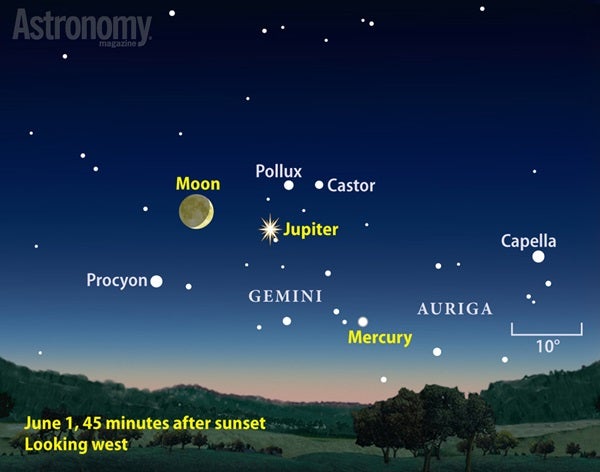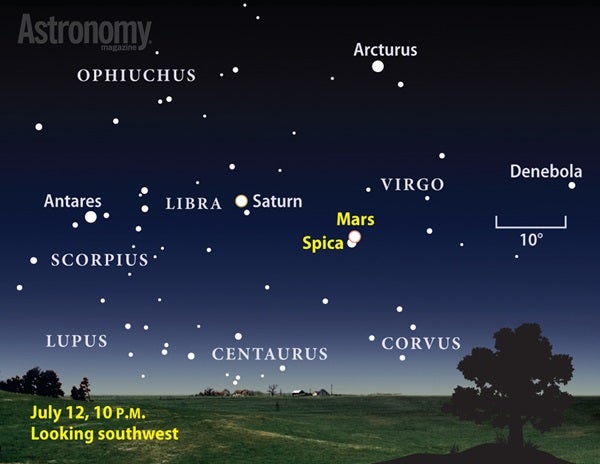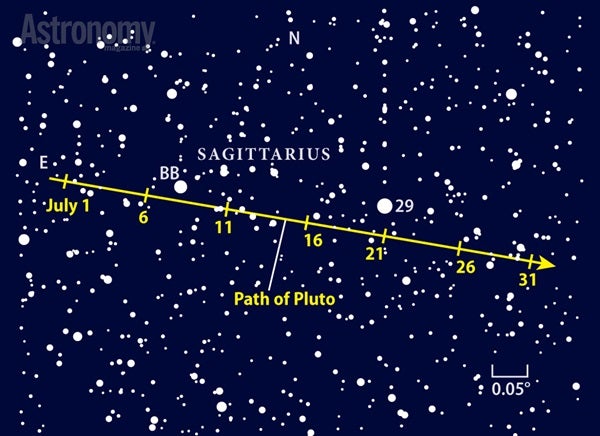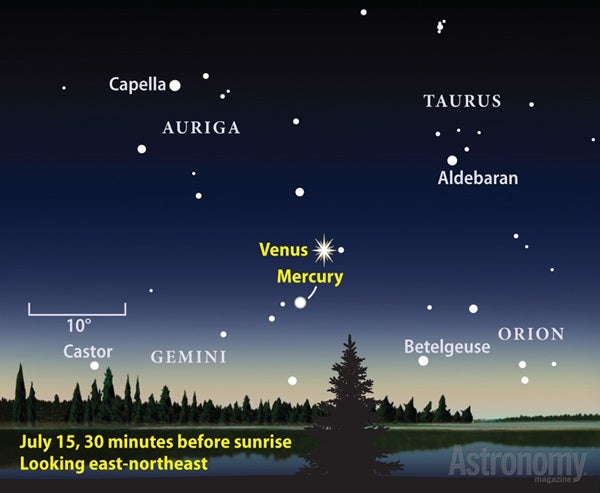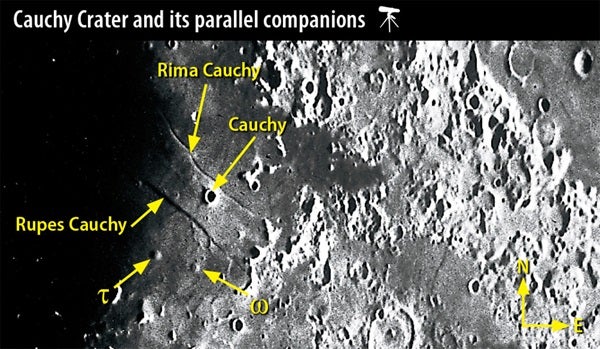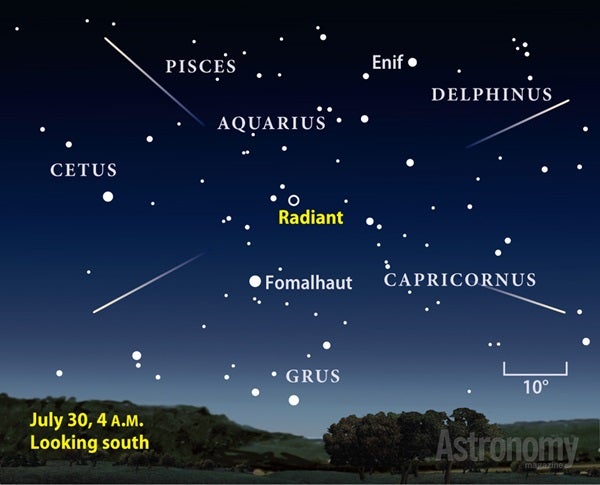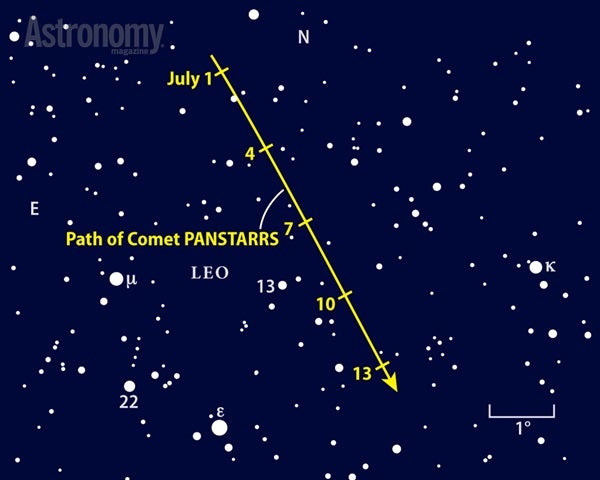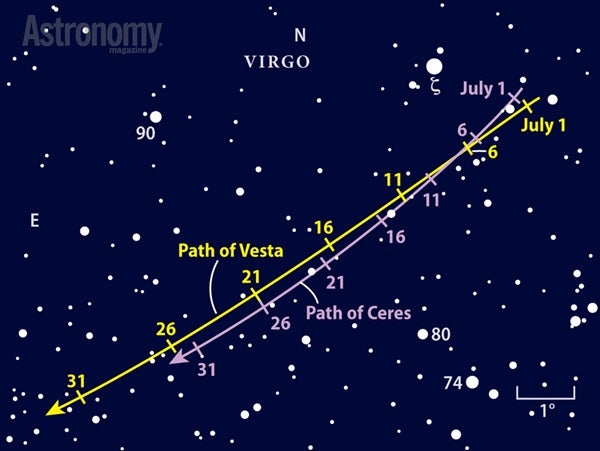Although summer nights are short, they still pack quite a wallop. Evening observers this July can enjoy wonderful views of Mars and Saturn, which offer a nice contrast in both color and telescopic appearance. The outermost planets, Uranus and Neptune, take center stage after midnight. Patient viewers at dark sites can spot these ice giant worlds easily through binoculars.
This month’s morning sky hosts Mercury and Venus. The two inner worlds shine brightly low in the east before sunrise. At the opposite end of the brightness scale, Pluto reaches its peak in July. You’ll likely need an 8-inch or larger telescope to spot this 14th-magnitude object visually. Fortunately, it lies in a part of northern Sagittarius that contains a couple of bright stars to guide you to the right spot.
Our tour of the solar system begins shortly after sunset in early July. On the 1st, Jupiter hangs 5° above the west-northwestern horizon 30 minutes after sunset. It shines brightly at magnitude –1.8, which is why it shows up despite the low altitude. The giant planet disappears after July’s first few evenings and passes behind the Sun from our perspective on the 24th.
Mars appears in the southwest as darkness falls all month. On July 1, it stands 5.5° northwest of Spica, the brightest star in Virgo the Maiden. The planet shines at magnitude 0.0, a full magnitude brighter (equivalent to a factor of 2.5) than the star. Mars’ orange glow contrasts nicely with Spica’s blue-white hue.
If you watch every clear evening in early July, you’ll notice these two objects are pulling closer to each other. On the 5th, a First Quarter Moon jumps between the pair. Across North and South America, our satellite appears within 1° of Mars. Observers in Central America and the northern half of South America will see the Moon pass directly in front of the planet and block it from view.
Mars’ eastward motion relative to the background stars continues throughout July. On the 12th, the Red Planet passes 1.4° north of Spica. The pretty conjunction will look best through binoculars or a telescope at low power. By month’s end, Mars has pulled 9° east of the star.
Although Mars remains visible until midnight local daylight time or later during July, the best views through a telescope come when it lies highest as soon as darkness falls. The planet shows a distinct phase, particularly around quadrature July 19. (At this configuration, the Sun-Earth-Mars angle equals 90° and the phase effect is greatest.) The planet’s 9″-diameter disk should display a few dark surface markings during moments of good seeing, when Earth’s atmosphere steadies and the view sharpens.
Saturn lies a short hop east of Mars among the stars of Libra the Balance. The separation between the two planets drops from 28° to 12° during July. The shrinking gap heralds an upcoming close approach — the two will pass 4° from each other in late August. This month, you’ll find the ringed world about 30° high in the southwest as twilight fades.
Shining at magnitude 0.4, Saturn appears more than two magnitudes brighter than any of Libra’s suns. The nearest 1st-magnitude star is Scorpius’ luminary, Antares, which stands to the planet’s lower left. Notice the contrast between yellowish Saturn and the orange hue of the red supergiant star.
Swing your telescope toward Saturn, and marvel at the golden globe encircled by a spectacular ring system. The planet’s disk measures 18″ across the equator while the rings span 40″ and tilt 21° to our line of sight. Look for the shadow of Saturn’s orb falling on the far side of the rings just off the planet’s eastern limb.
The ringed planet features several moons. The brightest, 8th-magnitude Titan, shows up through any scope. You’ll need a 4-inch or larger instrument to spy 10th-magnitude Tethys, Dione, Rhea, and Iapetus. Although the last of these varies from 10th to 12th magnitude as it orbits Saturn, it appears brightest well west of the planet in early July.
Mars and Saturn certainly stand out in the summer evening sky. Unfortunately, the same can’t be said for Pluto. The distant world glows at magnitude 14.1 — 1,000 times fainter than the naked-eye limit under a dark sky — among the background stars of northern Sagittarius. You’ll need an 8-inch or larger scope to detect its dim glow visually, though a camera can record it through a smaller instrument.
The dwarf planet reaches opposition and best visibility July 4, when it rises at sunset and climbs highest in the south around 1 a.m. local daylight time. Although its magnitude doesn’t change all month, it reaches peak altitude — the best time to search for it — a half-hour earlier every week.
To track down this object, first find 2nd-magnitude Nunki (Sigma [σ] Sagittarii), the star marking the northeastern corner of the handle in Sagittarius’ Teapot asterism. Next, locate 29 Sgr, a magnitude 5.2 star that lies 6° north and a bit west of Nunki. Pluto remains within 0.5° (30′) of this orange sun throughout July. A fainter star, the 7th-magnitude variable BB Sgr, resides 19′ east of 29 Sgr and also proves useful in detecting Pluto. These two anchor the finder chart above.
Pluto’s westward motion in July carries it 1.2′ south of BB Sgr on the 8th and 2.5′ south of 29 Sgr on the 21st. Whenever you observe, sketch or image the stars around Pluto’s position and return to the same field a night or two later. The object that moved is Pluto. Although it appears as a mere point of light, imagine what this frigid world really looks like. We’ll find out next July when NASA’s New Horizons spacecraft flies past this enigmatic world.
As midnight approaches, Neptune pokes above the eastern horizon. The magnitude 7.8 planet lies in central Aquarius and shows up fairly easily through binoculars. It climbs 40° high in the south by 4 a.m. local daylight time. To get to its position, draw an imaginary line between the 4th-magnitude stars Tau (τ) and Theta (θ) Aquarii. Neptune lies to the left of this line’s midpoint.
As July begins, Neptune stands 1.9° northeast of 5th-magnitude Sigma Aquarii. This gap dwindles to 1.4° at month’s end. A telescope at high power reveals the ice giant’s 2.3″-diameter disk and blue-gray hue.
Uranus lies one constellation east of Neptune, in Pisces the Fish, and trails about 90 minutes behind its sister world. The best views come as twilight starts to break and Uranus appears roughly halfway from the southeastern horizon to the zenith. The planet travels slowly relative to the background stars, so its position changes little all month. Look for it some 2° south of 4th-magnitude Epsilon (ε) Piscium.
Uranus shines at magnitude 5.8, which is bright enough to see with naked eyes under a dark sky. Binoculars easily bring it into view in the same field as Epsilon. Through a telescope at medium magnification, the planet shows a disk 3.5″ across with a distinct blue-green color.
As twilight first appears, Venus rises in the east. It shines brilliantly at magnitude –3.8, far brighter than any other point of light in the sky. The planet resides in Taurus the Bull in early July, passing 4° north of 1st-magnitude Aldebaran on the 2nd. It races eastward all month, crossing the northern tip of Orion on the 17th and 18th and traversing half of Gemini by the 31st. When viewed through a telescope, Venus’ disk appears 11″ across and nearly full.
Mercury makes a brief appearance in July’s predawn twilight. It reaches greatest elongation July 12, when it lies 21° west of the Sun and stands 7° high in the east-northeast 45 minutes before sunrise. Coincidentally, that morning Mercury also lies 7° east (to the lower left) of the much brighter Venus, which serves as a guide to the magnitude 0.4 innermost planet. Mercury maintains its altitude for the next few days and brightens slightly, so it becomes even easier to see. Point a telescope at the planet on the 15th, and you’ll see a nearly half-lit disk that spans 7.5″.
AN ANCIENT BLAST MARS A TRANQUIL SPOT
Mare Tranquillitatis — the Sea of Tranquility — wasn’t always calm and peaceful. A giant impact created this basin billions of years ago. Millions of years after that, lava erupted through cracks in the floor. The fractures tend to lie along stress lines created by earlier impacts that formed other large basins. A second round of upwelling lava caused the terrain to heave unevenly, producing cliffs (scarps); in other places, lava tubes collapsed into narrow depressions known as rilles. Nearby, some volcanoes pushed toward the surface, creating symmetric hills called “domes.”
Three days after New Moon, on the evening of July 1, the Sun rises on a fascinating area of Mare Tranquillitatis surrounding Cauchy Crater. The region lies along the terminator — the line that divides day from night on the Moon — just north of the lunar equator.
The crater itself is an 8-mile-wide impact feature with sharp edges, a sign of its relative youth. Immediately north of the crater appears the prominent rille Rima Cauchy. Years of tiny impacts have softened its edges. By July 3, the Sun has climbed higher in the lunar sky and shines directly into the rille, wiping out the shadows and making it all but invisible.
Parallel to the rille and just south of the crater lies Rupes Cauchy. Many Moon observers consider this prominent scarp second only to the famous Straight Wall (Rupes Recta). At lunar sunrise, the scarp casts a sharp shadow westward, but the dark line disappears a couple of days later.
A real bonus in this region is a pair of lava domes. Look for two small hills protruding into the sunlight. The eastern dome is cataloged as Omega (ω) and the western one as Tau (τ).
Return to this region again the night of July 15/16 (the Moon rises before midnight local daylight time) when sunlight shines from the opposite direction. The scarp’s dark line has been replaced by a white streak sitting in the setting Sun’s glare. The monthly cycle almost repeats July 31, but the Sun is then a few hours higher in the Cauchy region’s sky.
FIERY STREAKS FROM A WATERY CONSTELLATION
July is a fine month for meteor observing, particularly late in the month as the Moon shifts out of the morning sky, the nights grow longer, and the weather remains balmy. The best meteor shower is the Southern Delta Aquariids. Although it doesn’t produce a ton of “shooting stars” — you can expect to see 15 to 20 per hour at maximum — it maintains peak intensity for a few days.
The greatest numbers rain down in the hour or two before morning twilight begins July 29 and 30. The meteors appear to radiate from a point near the star Delta (δ) Aquarii. This area climbs reasonably high before dawn, particularly for observers at more southerly locations.
| WHEN TO VIEW THE PLANETS |
||
| Evening Sky |
Midnight | Morning Sky |
| Mars (southwest) |
Mars (west) |
Mercury (northeast) |
| Jupiter (northwest) |
Saturn (southwest) |
Venus (east) |
| Saturn (south) |
Neptune (southeast) |
Uranus (southeast) |
| |
Neptune (south) |
|
| |
||
A FRESH COMET BRUSHES THE LION’S MANE
If Comet PANSTARRS (C/2012 K1) lives up to expectations, observers who target it through a 4-inch or larger telescope should be in for a nice show. Astronomers predict this visitor from the distant Oort Cloud should reach 7th or 8th magnitude in July.
But don’t wait too long. The comet is approaching the Sun in our sky and will disappear in evening twilight by mid-July. The window of observing opportunity is tighter still because the Moon’s glow spreads its light into the evening sky as the nights tick past. The best views should come during the month’s first week. By the time the sky darkens completely, about two hours after sunset, PANSTARRS sits about 10° high in the west-northwest.
Before the sky grows fully dark, find the Sickle asterism that forms the head of Leo the Lion. Target Gamma (γ) Leonis, and pump up your scope’s power on this pretty binary star. The system’s two yellow stars follow a leisurely 510-year orbit and currently appear a comfortable 4″ apart.
Now that you have warmed up, you’re ready for the comet. First, identify 4th-magnitude Mu (μ) Leo and 3rd-magnitude Epsilon (ε) Leo, the two suns at the end of the Sickle’s curved blade. During early July, PAN-STARRS tracks to the south-southwest along a path that runs parallel to the imaginary line joining these stars.
As the comet approaches closer to the Sun, our star heats the icy nucleus and causes it to shed gas and dust. The gas molecules become ionized (losing one or more electrons), and the solar wind then blows these ions into a tail that points directly away from the Sun (toward the east). Pressure from sunlight pushes the ejected dust particles into a diffuse fan that curves gently away from our star.
A low-power view should reveal both tails. At higher power, the tails seem to sprout from a condensed inner region called the “coma.” If the comet produces lots of gas, you might detect the coma’s greenish hue.
CLOSE ENCOUNTERS OF THE ASTEROID KIND
Asteroids 1 Ceres and 4 Vesta appear closer to each other in early July than they have since astronomers discovered them in the 19th century’s first decade. On the evening of July 1, just 19′ separate them. The gap closes to 10′ — one-third the Full Moon’s diameter — on the 4th and 5th. Although they glow brightly enough to spot through binoculars, you’ll get a real thrill from seeing both in the same telescopic field.
Ceres is the largest object in the main asteroid belt between the orbits of Mars and Jupiter. Its gravity molds it into a spherical shape, which is why astronomers also refer to it as a dwarf planet. Despite its size, Ceres typically is not the brightest object in the asteroid belt. Vesta’s surface reflects a greater percentage of the light that hits it than Ceres does, and because it orbits closer to the Sun than its sibling, Vesta also receives more light. Ceres shines at magnitude 8.4 in early July, some three times dimmer than magnitude 7.1 Vesta.
To find the pair, start at 3rd-magnitude Zeta (ζ) Virginis. During early July, both asteroids lie within 1.5° of this star. The finder chart below shows stars to magnitude 8.8, so you should be able to tell which points of light are Ceres and Vesta. To confirm a sighting, plot a half-dozen stars visible in a low-power field of view centered near the objects’ positions. Return to this field a night or two later, and determine which pair of dots moved against the background stars.
Martin Ratcliffe provides planetarium development for Sky-Skan, Inc. from his home in Wichita, Kansas. Meteorologist Alister Ling works for Environment Canada in Edmonton, Alberta.

